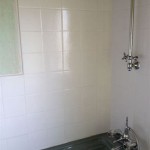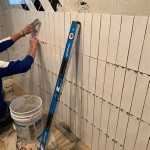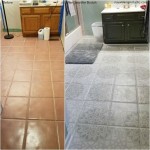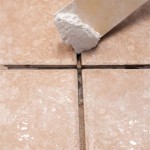Can You Install Ceramic Tile Directly on Concrete? A Comprehensive Guide
The question of whether ceramic tile can be installed directly on concrete is a common one for homeowners and contractors alike. The short answer is generally yes, but the success of the installation hinges on multiple factors. Directly adhering ceramic tile to concrete is a viable option under the right circumstances, but a thorough understanding of concrete properties, preparation techniques, and potential challenges is crucial for a durable and aesthetically pleasing outcome. Failure to address these aspects can lead to cracked tiles, loose grout, and costly repairs down the line.
Concrete, a widely used building material, possesses characteristics that can either facilitate or hinder tile adhesion. Its porous nature allows for bonding, but its susceptibility to cracking, moisture, and movement necessitates careful consideration. Understanding the existing concrete slab, including its age, condition, and history, forms the foundation of a successful tile installation. This involves conducting thorough inspections and performing necessary preparatory work before any adhesive is applied.
The direct application of ceramic tile to concrete eliminates the need for intermediary layers such as plywood or cement backer board. This can potentially reduce the overall project cost and installation time. However, this direct approach places a greater emphasis on the integrity and preparation of the concrete substrate. Choosing the correct type of mortar or thin-set adhesive formulated for direct concrete application is also essential. This ensures proper bond strength and flexibility to accommodate minor concrete movement.
Key Point 1: Assessing the Concrete Slab’s Condition
The initial step in determining the feasibility of installing ceramic tile directly on concrete involves a comprehensive assessment of the concrete slab itself. This assessment goes beyond a cursory visual inspection and delves into identifying potential problem areas that could compromise tile adhesion and longevity. Key aspects to investigate include:
1. Cracks: The presence of cracks, whether hairline or significant, indicates underlying stress within the concrete. Static cracks, which are dormant and unchanging, may be manageable with crack isolation membranes or patching compounds. However, active or dynamic cracks, which widen or shift over time, pose a greater challenge and may necessitate addressing the root cause of the movement before tiling. Filling the crack alone is usually insufficient as the movement will continue to impact the tile. The use of flexible grout and crack suppression membranes is often recommended in situations with minor unavoidable movement within the concrete slab.
2. Moisture Levels: Concrete is a porous material and can absorb moisture from the ground or surrounding environment. Excessive moisture can interfere with the adhesion of adhesives and promote mold growth. Prior to tiling, moisture testing is crucial. This can be accomplished using various methods, including calcium chloride tests (anhydrous calcium chloride), relative humidity probes, or plastic sheet tests. The results of these tests will determine whether a moisture mitigation system, such as a waterproof membrane or a penetrating concrete sealer, is required.
3. Surface Contamination: The concrete surface must be free of any contaminants that could impede bonding, such as dirt, dust, oil, paint, sealers, or curing compounds. These contaminants can prevent the adhesive from properly adhering to the concrete, leading to tile failure. Thorough cleaning using a degreaser, followed by rinsing and drying, is often sufficient. In some cases, mechanical abrasion, such as grinding or shot blasting, may be necessary to remove stubborn contaminants and create a profile for better adhesion.
4. Levelness: An uneven concrete surface will result in an uneven tile installation. Significant deviations in levelness must be addressed prior to tiling. Self-leveling compounds can be used to create a smooth and level substrate, ensuring a professional and aesthetically pleasing finish. Small imperfections can sometimes be accommodated by using a thicker bed of mortar, but this is not a recommended solution for larger discrepancies.
5. Curing and Age: Newly poured concrete requires adequate curing time before tiling. Premature tiling can lead to cracking as the concrete continues to shrink and hydrate. Generally, concrete should be allowed to cure for at least 28 days before tiling. Older concrete can also present challenges. Over time, the surface can become weak or powdery, requiring additional preparation to ensure proper adhesion. A scratch test, using a screwdriver or similar tool to assess the surface strength, can help determine if additional preparation is necessary.
Failing to adequately assess the concrete slab's condition can lead to tile failure, regardless of the quality of the tile or the adhesive used. Addressing these issues proactively will significantly increase the likelihood of a successful and long-lasting tile installation.
Key Point 2: Preparing the Concrete Surface for Tile Installation
Once the concrete slab has been thoroughly assessed, the next crucial step involves preparing the surface to ensure optimal adhesion of the ceramic tile. This preparation process is not merely cosmetic; it is fundamental to the long-term performance and durability of the tiled surface. Proper preparation will create a strong bond between the concrete and the tile, preventing issues such as cracking, delamination, and loose tiles. Several techniques can be employed, depending on the condition of the concrete and the demands of the specific installation.
1. Cleaning: As previously mentioned, the concrete surface must be meticulously cleaned to remove all traces of dirt, dust, grease, oil, paint, sealers, and curing compounds. Sweeping and vacuuming are essential for removing loose debris. For stubborn contaminants, a degreaser specifically designed for concrete can be used. The surface should then be thoroughly rinsed with clean water and allowed to dry completely. Avoid using harsh chemicals that could damage the concrete or leave behind residues. In some cases, pressure washing may be necessary to remove deeply embedded contaminants.
2. Grinding or Scarifying: Grinding or scarifying the concrete surface creates a mechanical profile that significantly enhances adhesion. This involves using specialized equipment to roughen the surface, creating a textured finish that allows the adhesive to grip more effectively. Grinding is typically used for smoother surfaces or to remove thin coatings, while scarifying is more aggressive and suitable for removing thicker coatings or creating a deeper profile. The choice of method depends on the existing surface condition and the type of adhesive being used.
3. Patching and Leveling: Any cracks, holes, or imperfections in the concrete surface must be repaired before tiling. Patching compounds specifically formulated for concrete repair can be used to fill cracks and holes. For larger areas or significant unevenness, self-leveling compounds are recommended. These compounds are designed to flow and create a smooth, level surface, ensuring that the tile is installed on a stable and even foundation. Allow the patching or leveling compound to fully cure according to the manufacturer's instructions before proceeding with the tile installation.
4. Applying a Primer: A primer or bonding agent can further enhance adhesion and improve the bond between the concrete and the tile adhesive. Primers penetrate the concrete surface, creating a more receptive substrate for the adhesive. They also help to seal the concrete, preventing moisture from being drawn out of the adhesive too quickly. Choose a primer specifically designed for use with concrete and the type of adhesive being used. Apply the primer according to the manufacturer's instructions, ensuring even coverage.
5. Crack Isolation Membrane: For concrete slabs prone to cracking, a crack isolation membrane can be installed to prevent cracks in the concrete from transferring to the tile. These membranes are designed to absorb movement and stress, protecting the tile layer from damage. They are available in various forms, including liquid-applied membranes and sheet membranes. The selection of the appropriate membrane depends on the anticipated movement and the specific requirements of the installation.
Thorough and meticulous preparation of the concrete surface is paramount for a successful and long-lasting tile installation. Neglecting these steps can lead to premature tile failure and costly repairs. Investing the time and effort to properly prepare the concrete will pay dividends in the form of a beautiful and durable tiled surface.
Key Point 3: Selecting the Appropriate Adhesive and Grout
Choosing the correct adhesive and grout is as critical as assessing and preparing the concrete slab. The adhesive, or thin-set mortar, is the binding agent that secures the ceramic tile to the concrete, while the grout fills the spaces between the tiles, providing structural support and preventing water penetration. Selecting the appropriate products depends on several factors, including the type of tile being used, the environmental conditions, and the specific requirements of the installation.
1. Adhesive Selection: Not all adhesives are created equal. Different formulations are designed for different types of tiles, substrates, and applications. For direct application of ceramic tile to concrete, a modified thin-set mortar is typically recommended. Modified thin-set mortars contain polymers that enhance adhesion, flexibility, and water resistance. Check the manufacturer's specifications to ensure the adhesive is suitable for use with ceramic tile and concrete. Consider factors such as the tile size, weight, and absorption rate when selecting the adhesive. Larger tiles or tiles with low absorption rates may require a specific type of modified thin-set mortar. Epoxy mortars offer superior strength and chemical resistance but are more expensive and require specialized application techniques.
2. Grout Selection: Grout serves not only an aesthetic purpose but also a functional one. It fills the joints between the tiles, preventing water from seeping underneath and damaging the substrate. Grout also helps to distribute weight and stress, preventing the tiles from cracking or shifting. The type of grout selected should be appropriate for the tile being used and the environmental conditions. Cement-based grouts are the most common and are suitable for most residential applications. Epoxy grouts offer superior stain resistance, chemical resistance, and durability, making them ideal for high-traffic areas or areas exposed to moisture and chemicals. Sanded grout is used for wider grout joints, while unsanded grout is used for narrower joints. Selecting the correct grout width and color is also important for achieving the desired aesthetic effect.
3. Application Techniques: Even with the correct adhesive and grout, proper application techniques are essential for a successful installation. Follow the manufacturer's instructions carefully when mixing and applying the adhesive and grout. Use the correct size trowel to ensure adequate coverage and bond strength. Apply the adhesive evenly and consistently, and avoid leaving any voids or air pockets. When grouting, pack the grout tightly into the joints and remove any excess grout from the tile surface. Allow the adhesive and grout to fully cure according to the manufacturer's instructions before using the tiled surface.
4. Consideration of Environmental Factors: Environmental factors, such as temperature and humidity, can also affect the performance of the adhesive and grout. Avoid installing tile in extreme temperatures or high humidity conditions. If necessary, take steps to control the environment, such as using a dehumidifier or heater. Ensure adequate ventilation during the installation process to prevent the build-up of fumes. Select adhesives and grouts that are specifically formulated for use in the anticipated environmental conditions.
Choosing the right adhesive and grout is crucial for ensuring a durable and long-lasting tile installation. Careful consideration of the factors outlined above will help to ensure that the tile is properly bonded to the concrete and that the grout provides adequate protection against water damage and other environmental factors. Consult with a tile professional or adhesive manufacturer for guidance on selecting the appropriate products for your specific project.
:max_bytes(150000):strip_icc()/can-you-install-tile-directly-on-concrete-1822600-04-458f7bb6c78348c1835cf8054ef36553.jpg?strip=all)
How To Install Tile Over Concrete

How To Install Tile Over Concrete Greenbuildingadvisor
How To Tile Onto Concrete Floors Porcelain Super
:max_bytes(150000):strip_icc()/can-you-install-tile-directly-on-concrete-1822600-01-8a89ceab1a274fb8ac81890ab7fc6b1b.jpg?strip=all)
How To Install Tile Over Concrete

How To Lay Floor Tiles On Concrete Welcome The Rubi Tools Blog
How To Lay Floor Tiles On Concrete Stonesuper

How To Install Ceramic Tiles On Concrete Floor Tile Installation

How To Install Ceramic Tiles On Concrete Floor Tile Installation

Can You Install Ceramic Tile On Top Of Vinyl Flooring 2024 Today S Homeowner

Sound Dampening Ceramic Tile Over A Concrete Floor Fine Homebuilding
Related Posts








